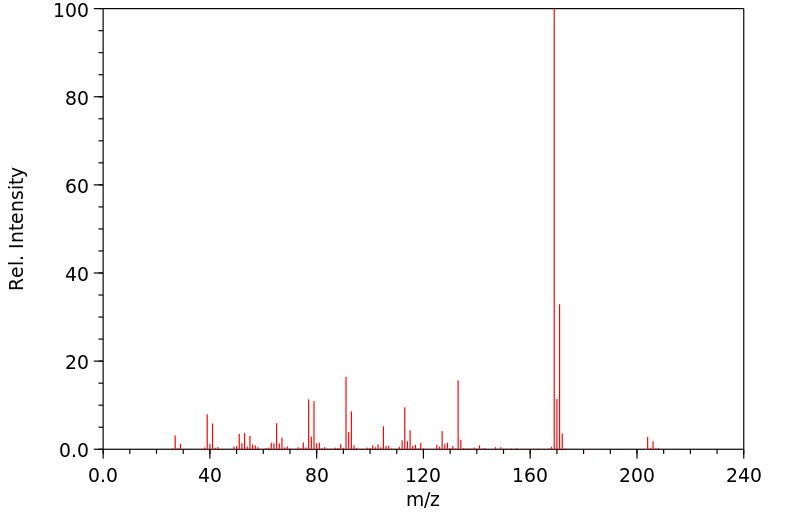1,3-二氯金刚烷 | 16104-50-0
中文名称
1,3-二氯金刚烷
中文别名
——
英文名称
1,3-dichloroadamantane
英文别名
1,3-Dichloradamantan;1,3-dichloradamantane
CAS
16104-50-0
化学式
C10H14Cl2
mdl
——
分子量
205.127
InChiKey
DZLCQHWJVJXVES-UHFFFAOYSA-N
BEILSTEIN
——
EINECS
——
-
物化性质
-
计算性质
-
ADMET
-
安全信息
-
SDS
-
制备方法与用途
-
上下游信息
-
文献信息
-
表征谱图
-
同类化合物
-
相关功能分类
-
相关结构分类
物化性质
-
熔点:130-131 °C
-
沸点:276.3±13.0 °C(Predicted)
-
密度:1.25±0.1 g/cm3(Predicted)
-
保留指数:1453;1453
计算性质
-
辛醇/水分配系数(LogP):3.3
-
重原子数:12
-
可旋转键数:0
-
环数:4.0
-
sp3杂化的碳原子比例:1.0
-
拓扑面积:0
-
氢给体数:0
-
氢受体数:0
SDS
上下游信息
-
上游原料
中文名称 英文名称 CAS号 化学式 分子量 1-氯金刚烷 1-chloroadamantane 935-56-8 C10H15Cl 170.682
反应信息
-
作为反应物:参考文献:名称:Sasaki, Tadashi; Shimizu, Kazuo; Ohno, Masatomi, Synthetic Communications, 1984, vol. 14, # 9, p. 853 - 856摘要:DOI:
-
作为产物:参考文献:名称:金刚烷及其衍生物与溴和一氯化碘的簇卤化摘要:发现金刚烷(AdH)与溴或一氯化碘的非催化卤化按照簇机制进行. 在与Br 2的反应中,选择性地形成1-AdBr。该反应被证明是 AdH 的一级反应和 Br 2的大约七级反应, 其速率不依赖于 HBr 浓度的上升。证明了AdH与ICl的反应是ICl中的六级反应,在第一阶段形成1-AdCl。根据动力学数据,该反应需要 3 当量的 ICl。结果表明,1-AdCl 氯化生成 1,3-di-Cl 衍生物的速率比 AdH 慢10 5倍。1-AdBr与ICl的卤素交换反应生成1-AdCl,该反应速度快,是ICl中的一级反应。另一个卤素交换反应,AdCl + Br 2 = AdBr + BrCl,进行得更慢,并且平衡强烈地向左移动(平衡常数:10 -6)。含有过量的 Br 2或 ICl,发现金刚烷醇 (1-AdOH) 进入缓慢的(与 AdH 相比)交换反应,分别产生 1-AdBr 或 1-AdCl。在所有研究的反应中,IClDOI:10.1039/d2ob01455f
文献信息
-
KOtBu as a Single Electron Donor? Revisiting the Halogenation of Alkanes with CBr4 and CCl4作者:Katie Emery、Allan Young、J. Arokianathar、Tell Tuttle、John MurphyDOI:10.3390/molecules23051055日期:——analogous known reaction of NaOH with CBr4 under phase-transfer conditions, where initiation features single electron transfer from a hydroxide ion to CBr4. We now report evidence from experimental and computational studies that KOtBu and other alkoxide reagents do not go through an analogous electron transfer. Rather, the alkoxides form hypohalites upon reacting with CBr4 or CCl4, and homolytic decomposition
-
Chlorination of aliphatic hydrocarbons, aromatic compounds, and olefins in subcritical carbon tetrachloride作者:Kiyoshi Tanemura、Tsuneo Suzuki、Yoko Nishida、Takaaki HoraguchiDOI:10.1016/j.tetlet.2008.08.082日期:2008.11The reactions of various substrates including aliphatic hydrocarbons, aromatic compounds, and olefins were investigated in subcritical carbon tetrachloride. Ketones and sulfones were stable under the employed conditions. The coupling adducts between olefins and carbon tetrachloride were obtained from the reactions of olefins.
-
Chlorination of various substrates in subcritical carbon tetrachloride作者:Kiyoshi Tanemura、Tsuneo Suzuki、Yoko Nishida、Takaaki HoraguchiDOI:10.1016/j.tet.2010.02.021日期:2010.4aliphatic hydrocarbons and the side chains of aromatic hydrocarbons were chlorinated in subcritical carbon tetrachloride. Chlorination of aromatic compounds including 1,4-disubstituted benzenes was investigated. Ketones and sulfones were stable under the employed conditions. Sulfoxides were converted into sulfides in a low to modest yields. The coupling adducts between olefins and carbon tetrachloride were
-
Chlorination of hydrocarbons with CCl4 catalyzed by complexes of Mn, Mo, V, Fe作者:R. I. Khusnutdinov、N. A. Shchadneva、A. R. Bayguzina、T. M. Oshnyakova、Yu. Yu. Mayakova、U. M. DzhemilevDOI:10.1134/s1070428013110018日期:2013.11Catalytic chlorination of alkanes, cycloalkanes, and adamantane utilizing tetrachloromethane as the source of chlorine and applying catalysts containing manganese, molybdenum, vanadium, and iron activated with nitrile ligands, alcohols, and water was fulfilled. The optimum ratios of catalysts and reagents and the best reaction conditions were found for selective synthesis of chlorine-substituted hydrocarbons
-
On the mechanism of liquid phase halogenation of adamantane derivatives
表征谱图
-
氢谱1HNMR
-
质谱MS
-
碳谱13CNMR
-
红外IR
-
拉曼Raman
-
峰位数据
-
峰位匹配
-
表征信息
同类化合物
顺式1,4-二氯-2-甲基-2-丁烯
顺式1,1,1,5-四氯-4-甲基-3-戊烯
顺式-7-甲基环庚-2-烯基氯
顺式-4-甲基环庚-2-烯基氯
顺式-1-氨基-4-氯-2-丁烯
顺式-1,4-二氯-2-丁烯
顺-6-氯-2-己烯
顺-4-氯-2-丁烯胺盐酸盐
锡烷,二(4-氯丁基)羰基-
锡烷,三氯(2-乙烯基壬基)-
重氮乙酰氯
辛基癸基二甲基氯化铵
聚乙烯胺
羟肟基乙酰氯
磷亚胺三氯化,[1,2,2,2-四氯-1-(三氯甲基)乙基]-
硫代氯甲酸-O-辛酯
癸醛,2,2-二氯-
甲醛与氨和氯乙烷的聚合物
甲基(2E)-2-(3-氯-2-丁烷亚基)肼羧酸酯
环己烷,(氯甲基)-
环丙烷,2-丁基-1-氯-1-(1-戊炔基)-,顺-
环丙烷,1,2-二溴-3,3-二氯-1,2-二丙基-,反-
环丙烷,1,1-二溴-2,3-二氯-2,3-二乙基-,反-
环丙烷,1,1-二氯-3-(氯甲基)-2,2-二甲基-
环丙烷,1,1,2,3-四氯-2,3-二甲基-,反-
环丙基甲基氯
环丁基氯
特比萘芬杂质17
溴代二氯丁烷
油酰氯
油酰氯
水合2-氯乙醛
氯螺戊烷
氯磺酸-(2,3-二氯丙酯)
氯甲醇
氯甲氧基
氯甲基自由基
氯甲基环丁烷
氯甲基氯磺酸酯
氯甲基二氯甲基醚
氯甲基(甲基)次磷酰氯
氯环辛烷
氯环癸烷
氯环庚烷
氯环丙烷
氯十七烷
氯化链烷烃
氯化环十二烷
氯化新戊烷
氯代环戊烷







